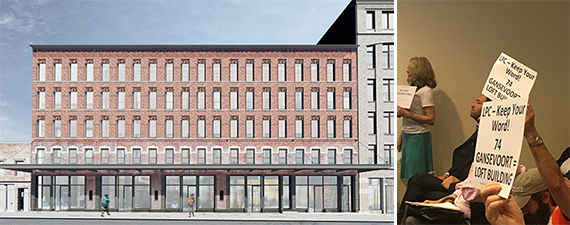Trending
Landmarks OKs controversial Gansevoort development
Opposition group asks for help from City Planning, City Council

The Landmarks Preservation Commission on Tuesday greenlit a new commercial development in the Meatpacking District despite squabbles over the project’s proposed height.
Landmarks granted the development certificates of appropriateness after the developers — Aurora Capital Associates and William Gottlieb Real Estate — proposed an altered version of their massive project planned for 46-74 Gansevoort Street. The developers plan to renovate and rebuild a stretch of the historic street to make way for 111,000 square feet of commercial space.
Newer designs shed a few feet off the height of the buildings and toned down detail on the facades. The new designs, however, failed to ameliorate concerns of community advocates, who argued that the buildings were still too tall for the neighborhood. Several members of the opposition group Save Gansevoort sat in the audience during Tuesday’s hearing, holding signs that said “Help Save Gansevoort Street” and “LPC-Keep Your Word!” After the commission approved the project, some members could be heard muttering “Bullshit” as they left the room.
“This is not over,” Elaine Young, a member of Save Gansevoort, said after the hearing. She said the group, in part, blames Mayor Bill de Blasio’s administration — which has had a love-hate relationship with the real estate industry — for the commission’s decision. “He’s shown no interest in landmarking and a total interest in developers.”
In a statement issued after the hearing, the opposition group urged the City Planning Commission and the City Council to “block any amendments to the restrictive declaration” on the sites that would allow for office space on the parcels.
“The commission’s ruling will not only destroy the last intact block of one-to-two story, market-style structures in Manhattan, but it is also the latest sign that unrestricted development is killing the unique character of so many of our city’s most beautiful neighborhoods,” the group said in a statement.
But Jared Epstein, vice president of Aurora, said the development is “as of right” and the future tenants will adhere to the restrictive declaration, which bars residential, hotel or office use.
“We have always said this neighborhood has not one but many histories, and today’s action ensures the complete story of its evolution over the past 130 years will continue to be told to future generations of New Yorkers,” Epstein said in a statement. “Today is an important milestone, and we are grateful for the guidance and input of local residents, stakeholders and particularly the Landmarks Preservation Commission.”
At a February meeting, the commission sent BKSK Architects back to the drawing board, arguing that the proposed buildings were too tall. BKSK came back with new plans that shed 9 feet from the height of 60-68 Gansevoort Street, making it 62 feet tall and four feet off 70-74 Gansevoort Street, making it 82 feet tall (excluding rooftop mechanicals). The plans also simplified the facade of 70-74 and included renovating 50 Gansevoort rather than demolishing it.
Much of the debate on the project has revolved around what historical period of the neighborhood should dictate the appearance of the redevelopment. Save Gansevoort argued that 60-68 Gansevoort should be 7 to 11 feet shorter than the height proposed in the latest designs, to match the style of the neighborhood’s original tenements. The group also claimed that the developers wrongly used existing warehouse heights, rather than nearby loft-style buildings, to justify the height of 70-74 Gansevoort.
Meenakshi Srinivasan, Landmarks chair, said that the new designs fit contextually with the surrounding neighborhood. Commissioner Michael Goldblum said the project did a good job capturing different layers of the neighborhood’s history, but found the height differences between 50 and 60-68 Gansevoort Street too drastic.
“It was rather jarring and noticeable,” Goldblum said.
Commissioner John Gutafsson, noted that the new designs created a project that perhaps didn’t please everyone but were in the “range of appropriate.”




